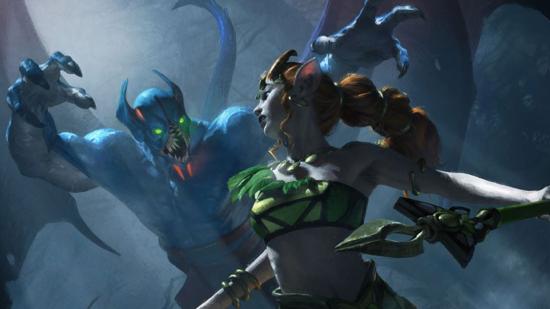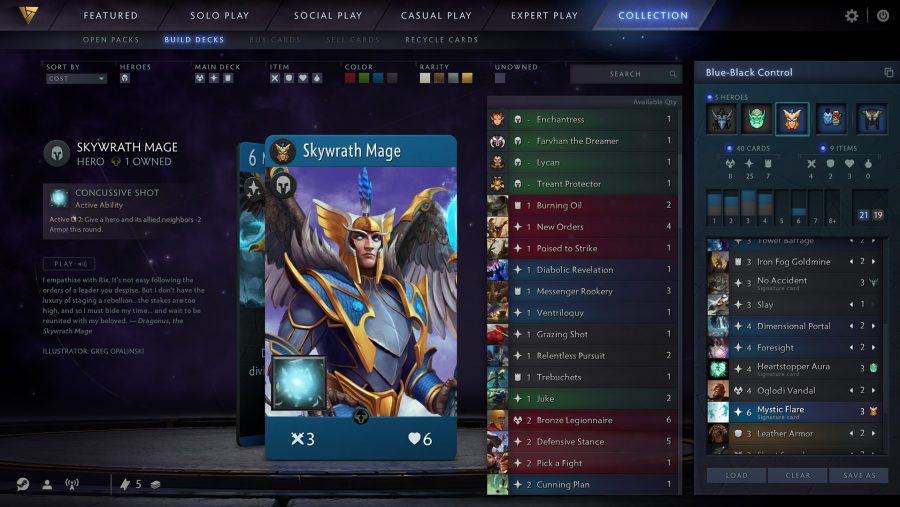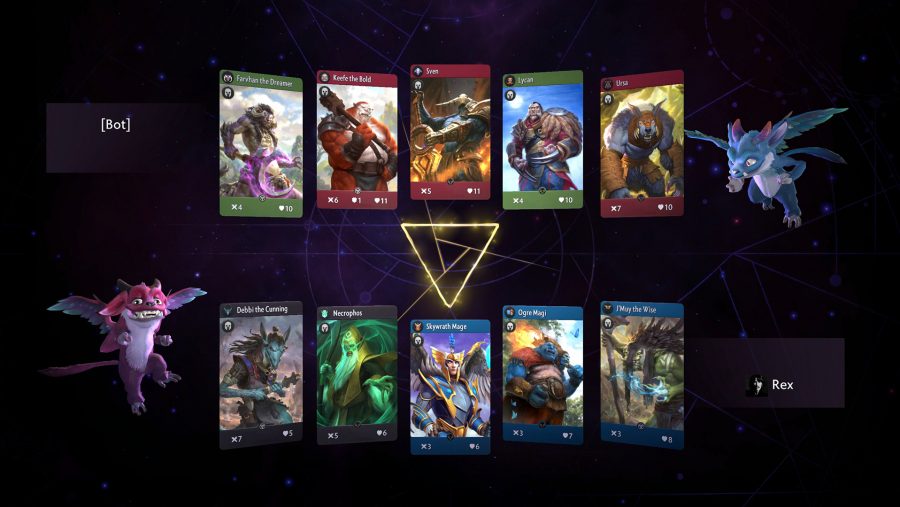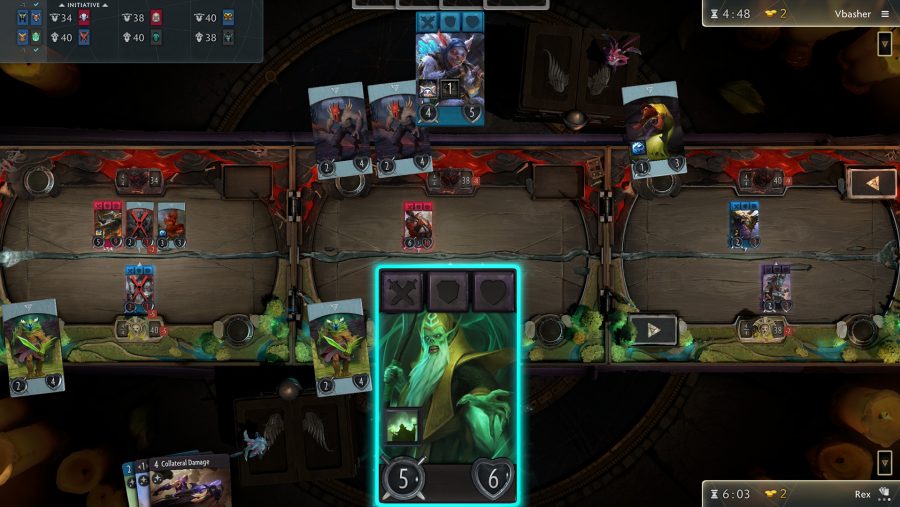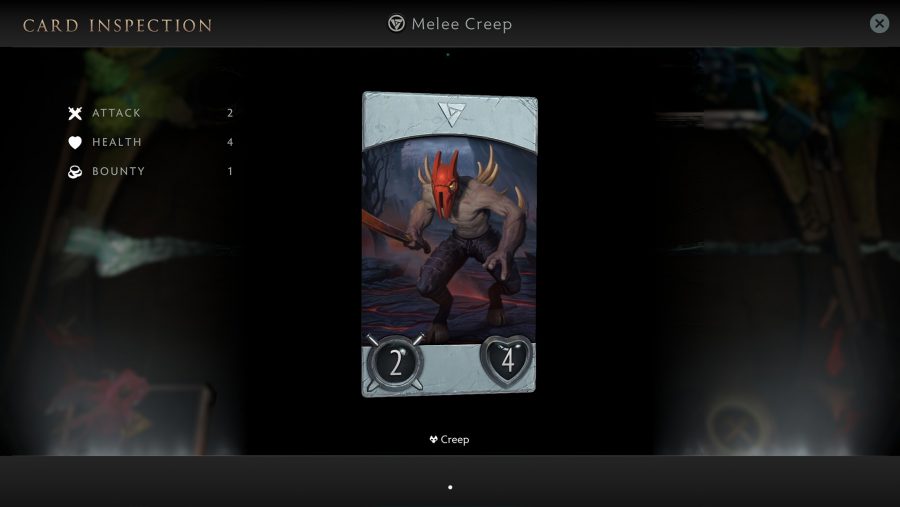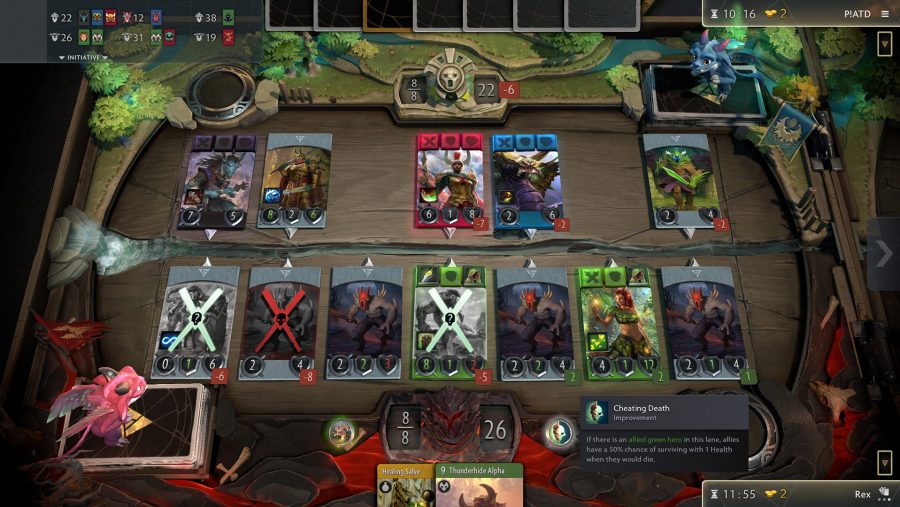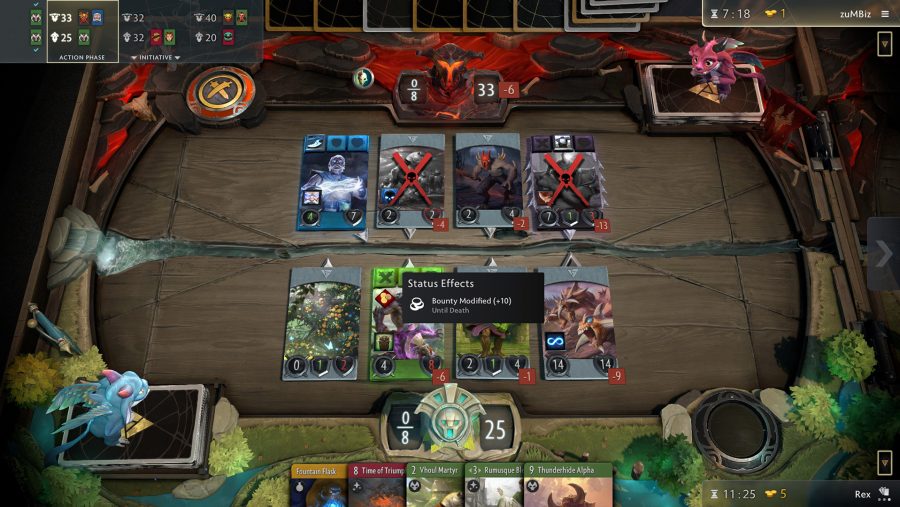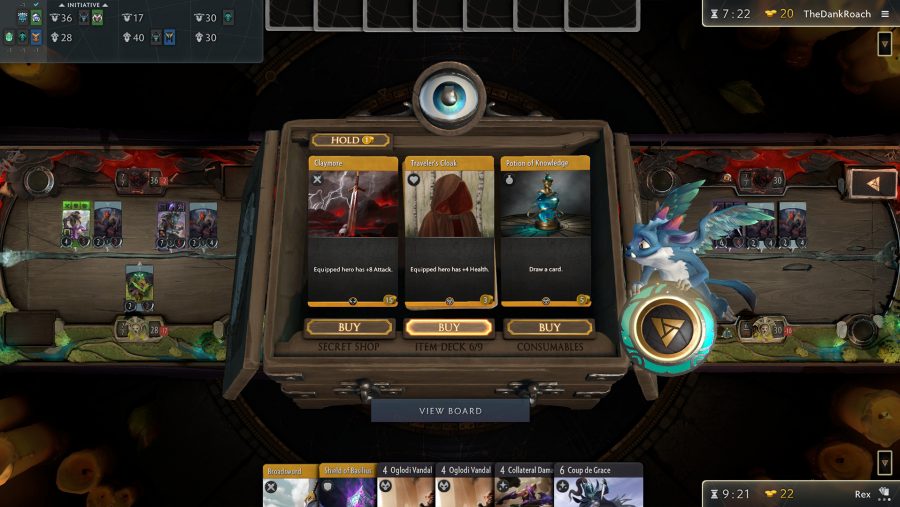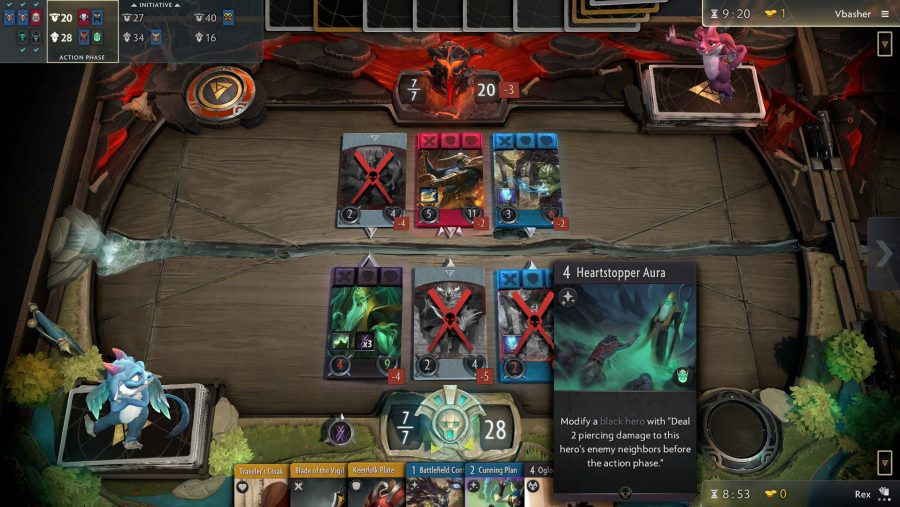Artifact, the new digital card game from Valve, is unlike any CCG or TCG you’ve played before despite sharing plenty of common ground and rules with Hearthstone and Magic: The Gathering. The key difference is that the action takes place on three boards, each representing a lane from Dota 2’s MOBA map.
You have a team of heroes – five, of course, to replicate the MOBA action – each of which can move between lanes and use a variety of powerful spells and abilities. They’re backed up by creeps, who spawn into lanes to represent the waves of NPC cannon fodder in Dota 2, and the myriad spells and abilities you can use from your deck of cards. Victory is achieved by winning battles in two of the three lanes.
Artifact is significantly more complex than its digital competitors, and while Valve’s built-in tutorial does a great job of explaining the absolute basics, there are plenty of nuances to the rules that it doesn’t cover. Luckily, we’re here to help you out. Here’s exactly how to play Artifact, step-by-step.
Here’s how to play Artifact:
ARTIFACT DECK BUILDING
The first vital component of Artifact is your deck of cards. Your deck has three components: the main deck, item deck, and heroes. You must have exactly five heroes – representative of the five heroes who would make up a team in Dota 2 – but while there are minimums of 40 cards for the main deck and nine for the item deck, there’s no upper limit to the number of cards you can have in either category.
Main deck cards and heroes are divided into four suits, identified by colour: red, green, blue, and black. Red cards tend to give you straightforward, high-damage attacks; green offer defensive magic and creep control; blue have high-power spells; and black give assassin-style abilities full of trickery and death manipulation. There’s a great deal of variance in how a deck can be built, but red and green decks tend to be equipped for victory in the early to mid game, while blue and black decks are most successful in the mid to late game.
The colour of your heroes determines which cards you can play, so those five cards will be the most important choice for your deck. You can build a deck with any number of colours represented, but one and two colour decks will have an advantage since they’ll have more choices in when and where to make use of their abilities. Your deck build also determines when each hero will come into play. Heroes in the first three slots go into play at the start of the match, while hero four comes in on round two and hero five enters play on round three.

You’ll choose the spells, improvements, and creeps that make up your main deck. Each hero you choose also brings three copies of its signature card. These cards will work particularly well in combination with that hero’s abilities, but they’re otherwise just like normal spell cards and can be played anywhere you could normally use a spell of that colour. This means that the first 15 cards for your main deck will be determined by your choice of heroes.
Because cards are shuffled back into your deck after playing them and not eliminated from play, you cannot run out of cards like in games such as Hearthstone. This means that small decks have advantages as you will be able to replay cards with more frequency than if they were part of a large deck. However, decks built with higher volumes of cards will offer broader possibilities, at the expense of having less control over the draw.
The final component of your deck is your selection of items. Items include weapons, armour, and accessories that you can equip on your heroes, as well as consumables that can grant various other effects. Item cards have no colour, and have to be purchased with gold earned in each match in a shop that appears between rounds, and your item deck lets you choose what selection appears at that shop. You must have at least nine items, but there’s no upper limit to your item deck. However, unlike your main deck, after you’ve purchased all your items they’ll no longer appear at the shop.
ARTIFACT HERO CARDS
Artifact hero cards are broadly similar to other card game characters – they have attack and health stats that dictate how much damage they can deal and absorb. Some start with an armour stat for damage reduction, or can receive it through various buffs. You can’t play a spell unless you have a hero of corresponding colour in that lane, so smart distribution of your heroes across the board is essential.
Heroes typically have a passive ability. For example, Sorla Khan has the Warmonger passive that deals an extra four damage when she attacks a tower. There are a few heroes who do not have a passive, such as Axe, due to their main health and damage stats being so high.
While heroes have stronger starting stats and more powerful passive abilities than most creeps, their main unique factor is that they can’t truly die. When a hero runs out of health, it’s temporarily removed from the board and placed in the Fountain. It will remain out of play for one full round, but can then be redeployed to any lane you choose.
Every hero can equip three items: one weapon, one piece of armour, and one accessory. Items provide heroes with passive buffs and new active abilities that can help turn the tide of battle. Once equipped, items are permanent – they’ll remain with that hero even after it’s gone to the fountain and been redeployed.
ARTIFACT LANES
With a deck built, it is time to start playing. Artifact plays out across three boards, each representing one of Dota 2’s lanes. Don’t worry if you have not played Dota 2 and don’t know the significance of lanes for a MOBA as, in Artifact, all it means is that you will be playing across three boards instead of one.
Each lane is split horizontally across the middle, separating it into zones for you and your opponent. There’s no limit to the number of cards that can be deployed in a lane – once you or your opponent has exceeded what can fit on screen, you can simply scroll left and right to see those extra cards.
On the very top and bottom edges of the board are towers. The bottom tower belongs to you and the top one to your opponent. The enemy tower is your objective: destroy two towers and the game is over. Towers have 40 health points. If you destroy one it’s replaced with an Ancient; an 80hp structure that also signals the end of the game if destroyed. That means there are two ways to achieve victory in Artifact: either destroy two out of three of your opponent’s towers, or destroy one tower in a single lane and then kill the Ancient.
You play through lanes in sequence. When a new turn begins you play actions on left lane, then move to middle, then right, and conclude the turn with a buying phase. Then the cycle repeats again.
Actions in each lane play out more or less independently of each other, but you have to make strategic decisions about where to make use of your heroes and other cards. Stick all your red heroes in one lane, for example, and you won’t be able to play red spells anywhere else. Some cards can have an effect in other lanes, too – you might choose to spend your mana in one lane so that you can have an advantage in another.
ARTIFACT CREEPS
Creeps are iconic in Dota 2. These small NPC creatures march up lanes and automatically attack enemy towers, and that is largely what they do in Artifact, too. Heroes and creeps make up the primary units on the board in each lane.
At the start of the game three melee creeps – a generic card with two attack and four health – will automatically spawn for both you and your opponent, and will be distributed randomly across the lanes. They could end up in separate lanes, or they might both end up in one. Two more melee creeps will spawn in each round after the first.
You can also spend mana to play creep cards from your hand. These will summon minions with unique abilities and different stats than the generic melee creeps. Some creeps have a play effect that happens when they first go onto the board, like Oglodi Vandal, which automatically deals four damage to the enemy tower when it enters play. Others can have passive effects which automatically happen when specific conditions occur, or active effects that you can repeatedly make use of after a brief cooldown.
Unlike heroes, once creeps are destroyed they’re gone for good. That might not be too terrible in most situations, but a powerful creep can outclass even your heroes in terms of pure damage, so protecting them smartly is essential.
ARTIFACT ATTACKING
Attacking the enemy in Artifact is very different to how it works in other card games. Rather than choosing a card and dictating which target it strikes, Artifact cards attack automatically. Both your heroes and creeps will attack units positioned directly across from them on the board.
If there’s no unit directly in front of yours, a target will be selected semi-randomly. There’s a 50% chance of attacking straight ahead, and a 25% chance of attacking diagonally left or right. Your cards will never attack at nothing – if this selection doesn’t land on an enemy unit, your card will instead attack the opposing tower directly.
If there’s an empty space on your side of the board in front of an enemy unit, a new creep or hero must go there. That’s true whether you’re placing the unit yourself or the game is randomly choosing its position. Otherwise, units can be placed into any open space, including the two slots on the far left and right of the board.
Some cards allow greater control over your positioning and attack direction. A creep like Rebel Decoy can swap positions with any other unit in the lane. Other spells and effects allow you to choose a specific target for your units – or allow you to redirect the attacks of your opponent’s units. While much of your positioning and attack direction is chosen at random, you have plenty of power to influence the specifics.

ARTIFACT MANA
Every card you play from your hand – except for items – has a mana cost, and this limitation will determine how you can play your spells, improvements, and creeps. Drawn from your main deck, these cards inflict deadly damage upon your opponent and provide potentially game-changing buffs for your own heroes.
Spells can include anything from straightforward damage-dealing attacks to stat buffs and position manipulation. Creep cards will summon minions into your lane, and improvements will alter a lane with special conditions that will be good for you and bad for your opponent.
There are some limitations for playing these cards. A card from your hand can only be played in a lane where there is a hero present that belongs to the same card suit. So, for instance, if you are intending to play a blue spell card, it can only be played in a lane where you have a blue hero.
As with games like Magic: The Gathering and Hearthstone, casting spells and ability cards costs mana. Also like those games, mana builds as the game progresses. The key difference with Artifact, though, is that you have three unique mana pools – one for each lane. These can all be different values. For example, your top and bottom lanes may have five mana, while your middle lane could have seven thanks to a buff provided by a hero. There’s no upper limit to how big a mana pool can get – they will continue increasing indefinitely until one player achieves victory.
Most cards will only take effect in the lane where they’re played, but there are exceptions. If you see arrows to the left and right of a card’s mana cost, that means it can affect any of the three lanes. You’ll see this on some spells and on every improvement card. The mana cost and hero suit requirements only apply in the lane you’re playing the card from – so you could stick a green improvement in a lane with no green heroes, or use a spell on a lane where you’ve already spent all your mana.
The modify keyword is a major factor to keep in mind while playing cards. Some effects last only for a single round, while modifying effects are permanent. If you play a modify attack buff on a creep, that bonus will last until the creep is destroyed. If you modify a hero, the effect will continue even after the hero’s been destroyed, gone to the fountain, and returned to the board.
ARTIFACT GOLD AND KILLS
In total, you have four different targets in Artifact: heroes, creeps, towers, and Ancients. Destroying towers and Ancients are your key objectives, but defeating enemy heroes and creeps is a major part of the game. The fewer heroes and creeps present in a lane, the easier it is to focus on attacking the opponent’s tower. Removing heroes and creeps obviously reduces the threat your opponent poses to you, but each kill also rewards you with gold.
Creep kills reward one gold piece, while killing a hero rewards five gold pieces. This currency is then used in the buying phase.
You can also alter the bounty received for killing heroes with certain cards. Bounty Hunter’s signature card, Track, will give a hero +10 bounty until it dies – meaning an extra ten gold for you when you kill it. The Revtel Signet Ring will give reduce an your hero’s bounty by three, meaning a bit less gold for your opponent if they manage a kill.
ARTIFACT ITEM SHOP
After you have completed actions in all three lanes, a turn of Artifact concludes with the buying phase. This is where you can spend gold to purchase items – either equipment for your heroes or consumables to use directly.
This is where you’ll see your item deck. A randomly selected item will be chosen from this deck to be available for purchase, and once you’ve bought it you’ll be able to purchase the next item in line. Once you’ve purchased everything from your item deck, these cards will no longer be available.
But there are other things to purchase besides what’s in your item deck. The consumables selection includes healing potions, a town portal scroll to return a hero to the fountain, and a Potion of Knowledge that allows you to draw an extra card. None of these items can be part of your deck – they only appear in the consumables shop.
Then there’s the secret shop, which randomly rotates through every single item available in the game, giving you access to equipment you might not otherwise be able to receive. If you see an item here that you want but you can’t afford just yet, you can spend one gold to hold it until the next round.
Equipment items fall into one of three categories – weapon, armour, and accessories – and heroes can have one of each equipped. All equipment items offer a passive buff but some have more complex active abilities. For example, Blink Dagger allows you to teleport a hero from one lane to another, and Horn of the Alpha summons a Thunderhide Pack creep. In addition, some items demand trade-offs – Ristul Emblem upgrades a hero’s health by +4 but reduces armour for both your hero and its opposing unit by -2.
ARTIFACT TURNS
By now you should understand the basic premise of an Artifact round: you perform actions in sequence in the left, middle, and right lane, then complete the buying phase, and then conclude the round. But there are small phases that occur in turns which make up each part of the round.
At the start of a round you’ll have the spawning and placement phases, where the game distributes melee creeps for you and you can choose which lane heroes freshly returned from the fountain will deploy in. Then you’ll reach the drawing phase, where each player draws two cards from their main deck.
Play in each lane is then divided into the action and combat phase, and this is where things get a bit more complicated.
In the action phase, players take actions in turns until they’re both done. Imagine a scenario in which you decide that, on this turn, there are no cards that you wish to play in the left lane. You end your action, and control swaps to your opponent. They then play a card that endangers your position. Instead of the left lane phase being over, though, control swaps back to you. You can now play a card to counter your opponent, provided you have a card you wish to play and enough mana remaining to cast it. After making your move, you pass control back to your opponent, who can now play a card to counter your new move, or end their action without playing. The left lane phase only ends when both players agree that they no longer wish to make a move, or it is impossible for either to perform one. The action then swaps to middle lane and the whole process plays out again.
The player who passes first at the end of the action phase will get initiative and will then be able to play first in the next lane. If you’ve got initiative, you’ve usually got an advantage. For example, you could cast a damage spell that kills an enemy hero and prevents your opponent from playing spells in that lane. But there will be other situations where you want your opponent to go first, either to see what they’re planning and counter it or to make sure they’ve used up all their mana and can’t counter your own play.
Once the action phase is complete, there’s the combat phase, which is much quicker and simpler. Here, all heroes and creeps make their attacks simultaneously. If two opposing units can each do enough damage to kill each other, they’ll both be destroyed. You can see what the results of the combat phase will be at any point during the action phase and take actions accordingly to affect the results.
To further complicate things, each lane phase is split into further segments. Certain abilities will activate before the main action phase, or at other specified points during a round. Understanding which abilities will activate when is paramount to a successful attack.
If you’re looking for even more useful pointers from us, then we’ve got a complete list of all Artifact cards for you to read through, or a rundown of our favourite Artifact decks for beginners if you’d prefer.
And that is how to play Artifact. While the rules are much more complicated than something like the friendly and accessible Hearthstone, it’s surprisingly easy to pick up the basics and move into strategic play. Provided, of course, that you have a helpful guide to look at when the details get murky.
